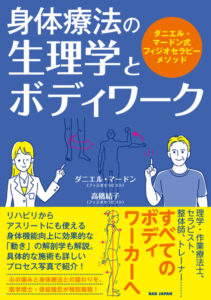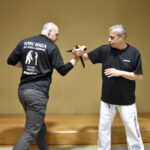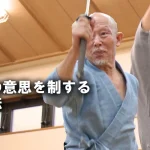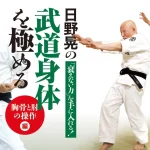【Exploring the spirit of the Ryukyu】Series 7 (HIDEN 11/2023)「Shimabukuro Zenpo SENSEI」

SHIMABUKURO ZENPO 10th DAN HANSHI (Translation from “HIDEN” magazine; November 2023 issue).
7th episode, SHORIN-RYU SEIBUKAN DOJO
Interview/text: Daniel Mardon
Photography/translation: Yuko Takahashi
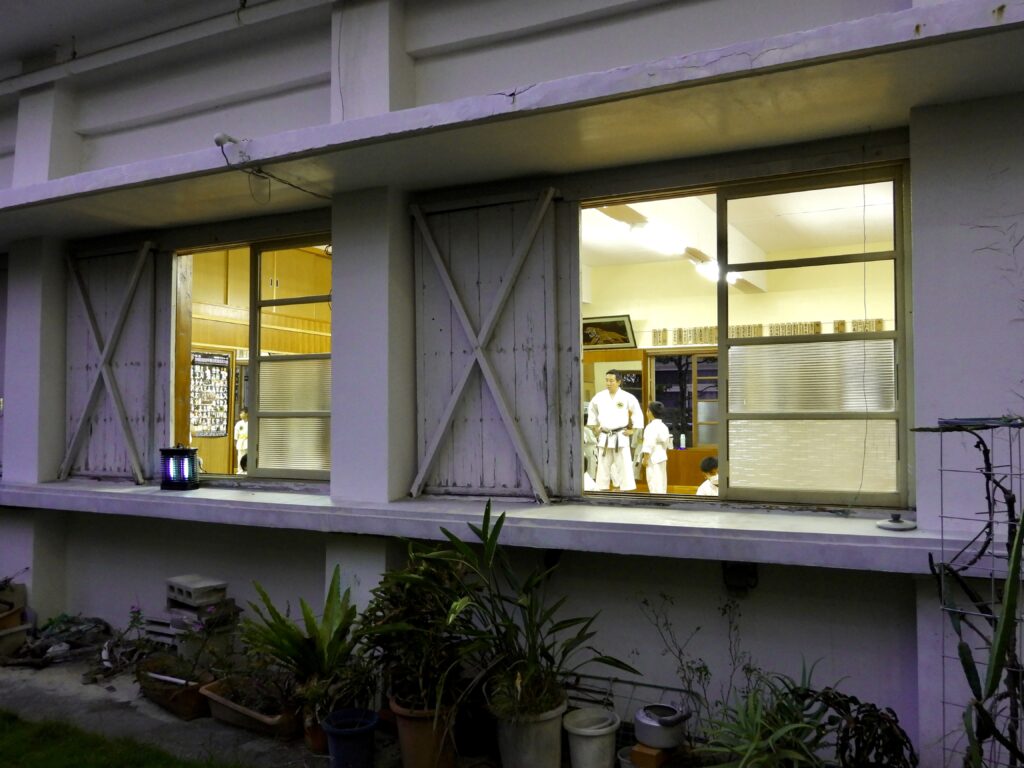
This Dojo was built with an architecture designed by Zenpo Sensei when he was still a young student. The window system intended to ventilate as best as possible is still intact.
We are visiting another emblematic Dojo, located in Chatan and which was built in 1962 by Shimabukuro Zenryo Hanshi, 10th Dan (1908-1969).
Remaining intact in its original state, only the floor has been redone 3 times. A good wood flooring is, according to tradition, the most important part of a Dojo. It is important to remember that the unique particularity of these “Vintage” Dojos from Okinawa is to have the teaching of Karate coexisting with the private residence of the Master. Their special architectural model allows this perfect harmony.
Thus, it is often by chance that passerby discover the existence of a Dojo, or by a piercing “kiai” covering the songs of the tropical birds.
Okinawa has been immersed into Karate for centuries and with the greatest representatives, but the teaching has always taken place in secret. It was only after the war and in the early 1950s that Karate became more accessible. All the Masters of this generation admit that the great interest aroused in Karate by the American occupation is the main factor for its development.

In front of the entrance to the Shorin-ryu Seibukan Okinawa Sohonbu Dojo. Daniel Sensei (left), Kancho Shimabukuro Zenpo Sensei (center), Vice Kancho instructor Shimabukuro Zenshun Shihan
Shimabukuro Zenryo Hanshi, who was the father of the current kancho Shimabukuro Zenpo Sensei, was a “senior disciple” of the great Master Kyan Chotoku (1870-1945). Shortly after the war and the death of his Master, Zenryo Hanshi began teaching for his neighborhood in his house. The Dojo was in fact, a small wooden floor of 6 tatami (approximately 10 m2). The particularity was that the family house was located near what became US Army Camp Zukeran.
A few years later, an American parachutist knocked at the door and asked for admission. He was admitted and became the first foreign student of the Shimabukuro Dojo. A friendly relationship resulted and the soldier suggested that the Sensei should come and teach on the base with his son Zenpo for first assistant. This took place around 1958 and the young Zenpo who was only 16 years old,
found that the gymnasium allocated to them was not suitable. Zenpo Sensei told me that in the very beginning, they had to teach between pool tables!
Because of the different sports that were practiced in the gymnasium, it was not allowed to leave Kobudo weapons as well as the effects that determine a Dojo. The young Zenpo suggested to his father that they must build their own Dojo. This requires strong determination, but after discussions, the father decided that it is a good idea.
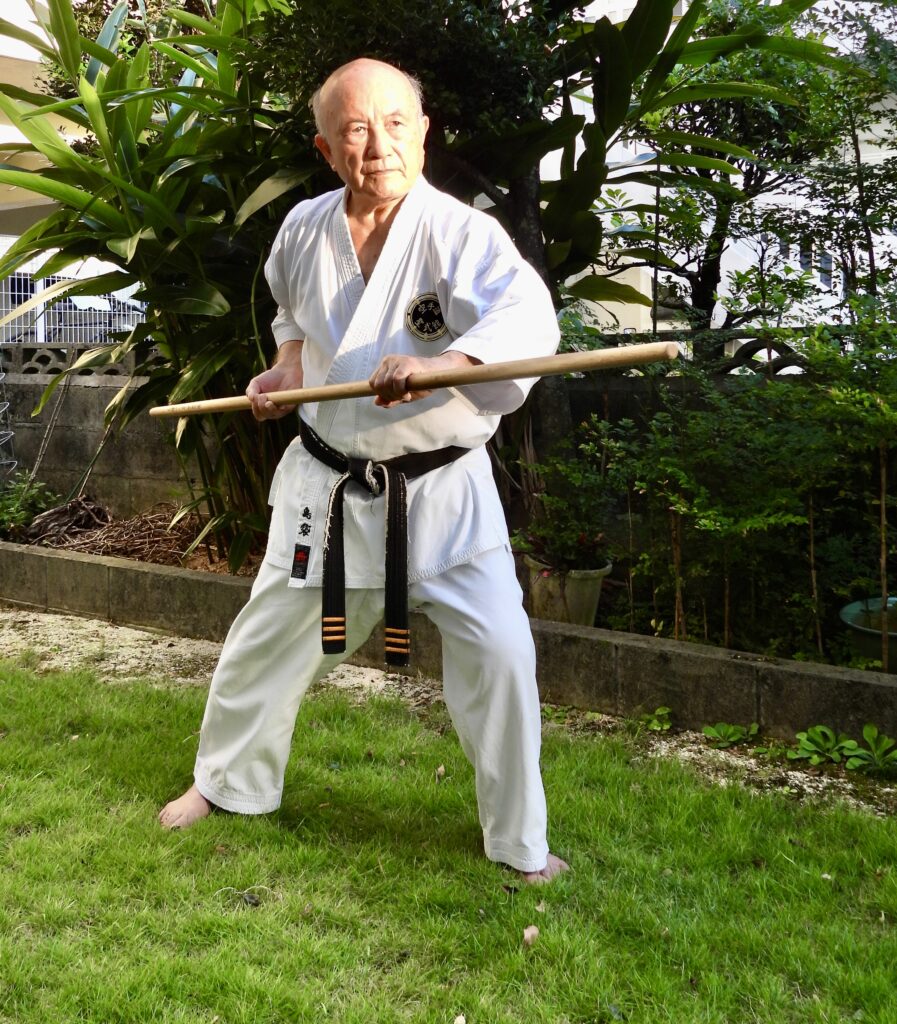
In the tropical garden of the Dojo. The ancient art of “Tokumine-nu-kun” was taught by Kyan Chotoku to Zenpo Sensei’s father (Shimabukuro Zenryo).

Superb Sun-light in the Dojo garden.

Yuko Takahashi Sensei likes to practice Bo. She is posing here with us after another quality interview.
At that time, Okinawa did not have machines to mix concrete and construction work had to be done by hand. Fortunately, “Yuimaru” (mutual assistance) is a cultural concept of Okinawa and it was therefore with the precious help of neighbors as well as a few students that the project was carried out.
It was also the young high school student Zenpo who designed the special shape of the windows; allowing better ventilation and greater resistance to typhoons. He also calculated the height of the ceiling in order to allow the use of Kobudo weapons. Apart from the floor, everything is original and still in perfect condition. This Dojo is art added to art!
This late autumn afternoon is still very hot and as always in Okinawa, the training will last several hours. Zenpo Hanshi and his eldest son Zenshun Shihan are welcoming us in front of the Dojo and under a sublime orange sunset. I am thrilled and I can say that I really love Okinawa!
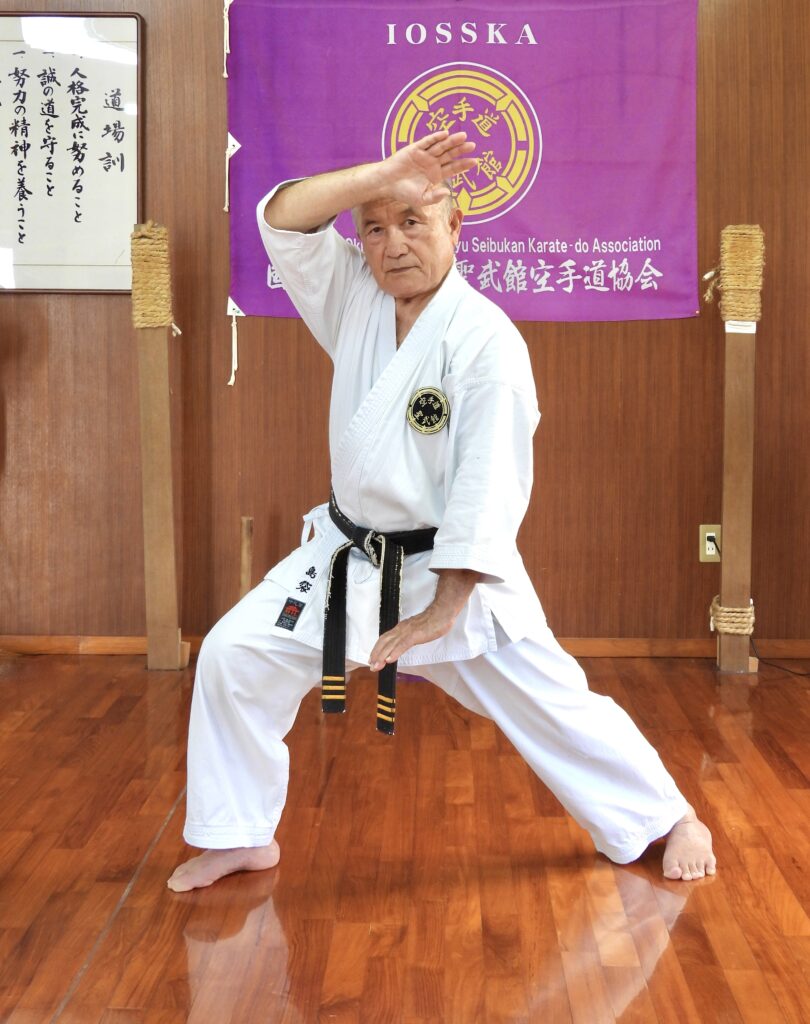
Biography of Shimabukuro Zenpo
Chairman of the International Okinawa Shorin-Ryu Seibukan Karate Association (Hanshi 10th Dan). Advisor to the Okinawa Karate Federation as well as the Kobudo Federation.
Born in 1943 in Chatan, Okinawa Okinawa Prefecture.
In 1963, he left for 3 years in the USA in Pennsylvania to teach Karate. The same year, he won the Pittsburgh Kumite Championships. In 1964, he won the Canadian Kumite Championships. In 1965 he won the U.S. Kata Championships in Washington DC.
In 1969, he inherited the Seibukan Karate Dojo and became its Kancho (Director).
In 1976, he became the President of the Shorin-Ryu International Seibukan Karate Association.
In 1990, he participated in the 1st “Uchinanchu Karate Kobudo World Exchange Festival”.
In 1996, he participated in the demonstration for the Atlanta Olympic Games.
In 1999, he became President of the new Association; “International Okinawa Shorin-Ryu Seibukan Karate Association”. Instructor for numerous courses in the U.S. and speaker during the tour of the U.S.A. caravan and the “1st Okinawa Traditional Karate Kobudo Tournament. He taught 1,500 people.
In 2008, he received a 10th Dan from the “Okinawa Karate and Kobudo Federation” as well as a distinction from the Ryukyu Shimposha.
In 2009, he also obtained a 10th Dan from the Karate Federation.
(1-) Why did you start karate?
My interest in Karate probably came from watching my father who was teaching and practicing at home…. I was 9 years old when my father started teaching on our 10 m2 floor. I found it wonderful.
(2-) What are the characteristics of your Ryuha/Dojo?
Our Shorin-Ryu Seibukan is characterized by agility as well as the power of its techniques. We attach a lot of importance to the basics. For example, how to give good “Tsuki”, perform “Keri” (kick) with skill and also “Tachikata” (knowing how to position yourself well). These “Kihon” (basics) represent more than 30 minutes of the course. It is only when the Kihon begins to be mastered that we move on to the Katas. Then we work on “Yakusoku kumite” (coded kumite), “Jiyu Kumite” (free kumite), “Kata-bunkai” (disassembly), “Kote kitae” (arm conditioning), etc….
Our Dojo is also the only one that has inherited and officially transmits the “Shaken” (diagonal fist) from Kyan Chotoku Sensei.

Zenpo Sensei demonstrates the “Shaken” (diagonal fist); personal heritage of Kyan Chotoku, which is only officially taught at this Dojo.

Zenpo-Sensei teaches the “Keri” (kick) in an original way by placing his foot on the student’s supporting foot so that it doesn’t pivot.

The super-trained fist that Zenpo Sensei forged. The method consists of ensuring that the fist is irrigated by a good blood flow.

Basic training in traditional Okinawan “Makiwara”.
(3-) What is your specialty?
I would say… to overtake my opponent with greater speed and in one move only! Also carrying out blocks and attacks made invisible by their speed of execution. [By knowing Shimabukuro Zenpo Sensei well, I can confirm that he has remarkable speed, especially considering he has just celebrated his 80th birthday!]
(4-) What is the most impressive memory of your Shisho (Master)?
My Shisho was my father; Shimabukuro Zenryo Hanshi. He loved Karate and was a strict but kind teacher. Every morning, my father was at the Dojo doing “Makiwara” from 5 a.m.! Bang! Bang! It was my morning wake-up call! He was very hard on himself. In addition to serving in administrative positions regarding Karate, he was the President of our local community. Civic duties are very important in Okinawa. My father was a man who helped the sick and everyone in need. He had a very strong sense of justice.
My father had started Karate after knocking at the door of Master Kyan Chotoku…. At that time, Okinawa had a very convenient railway line (“Keibin Tetsudo”), which served Naha, Yonabaru, Chatan and Kadena and so we were connected to the main centers. Before it was destroyed during the “Battle of Okinawa” in 1945, the “Keibin Tetsudo” was widely used by everyone. Merchants and students loaded bikes and equipment there. My father who worked in confectionery used this train. After work, he would go to train with Kyan Sensei who was living on the shore among the mangroves of the Hijagawa River/Lake in Yomitan.
My father wrote his memoirs meticulously and one could read for example: “Today, like every morning, I got up at 5 o’clock, I went running in the hills of Chatan, then I hit the Makiwara, I did a few Kata 5 times, then I showed a series of Kata to Chibana Choshin Sensei.
Chibana Sensei lived in Shuri, but very often came to Chatan to see his niece who lived right next to our Dojo. Chibana Sensei always stopped by to see my father, taught him Kata and talked at length together.

The photo of Kyan Chotoku (left) and Shimabukuro Zenryo Hanshi are watching over the Seibukan Dojo.

“Yakusoku Kumite”. Shimabukuro Zenryo Hanshi (left) and his son Zenpo Sensei (1966).
(5-) What is the difference between Okinawa Karate and Mainland Karate?
Okinawa is the source…
I believe that the “Shihan” (instructors) of Okinawa went to teach for short periods of time in Japan. They transmitted a form of Karate lacking “Honshitsu” (essence). I think that this popularization throughout the world has caused Karate to deviate from its traditions.
In Okinawa, the Deshi (disciples) train under the eyes of a Shisho (Master) for a period of 5 to 20 years or more, in order to learn the “Honshitsu” of Karate.
After that, they can ask their Shisho for permission to open a Dojo and to teach.
Daniel Sensei:
My “Ryuha” is Shotokan, but I find that Shorin-Ryu is the one that resembles the most out of all the Okinawa Ryu…. Why?
All styles of Karate in Japan are based on either Shuri-Te or Naha-Te from Okinawa… The history of Shotokan begins with Funakoshi Gichin Sensei, who was a disciple of both Masters Itosu Anko and Asato Anko; who were themselves disciples of Matsumura Sokon. Matsumura Sokon is the base of Shuri-Te.
PERSONAL NOTE :
Japanese is an extremely difficult language that also involves many cultural considerations. For example, today schoolchildren and motorists are still taught that traffic lights are blue-yellow and red…. Although the Japanese know the color green, they describe it as blue in this case. This interpretation is due to cultural references. This is also why schools still teach 2 ways to read Kanji. One is called “On-Yomi” (sound-reading) and it involves the pronunciation of Chinese origin. The second is called “Kun-Yomi” (Japanese way of reading). Japanese people write and read both without being really aware of it. Also take in consideration that they have 2 alphabets (Hiragana & Katakana) made of at least 46 letters each, plus the Kanji which number in the thousands and each of which has several meanings…. So we look quite small with our constructions of words based on the 26 letters of our alphabet. Many things confuse and shock Western logic which always wants to explain everything. As I often say, there is no “short-answer” to explain the Japanese language…
In regards to the word “Shorin”, it is suggested that this word was created in Okinawa by the Masters of Shuri-Te (Sakugawa Sensei, etc.) with a reference to Shorin-ji (Shaolin Temple) and some historians want to see also a reference with “Shuri”… The word “Ryu” (style) would have come later for the purpose of semantic unification after the creation of Goju-Ryu by Miyagi Chojun Sensei.
3 slightly different Shorin groups would have formed by differentiating themselves with their first Kanji :
-1)小林, -2)松林, -3)少林. The 3 read “Shorin” in “On-Yomi”.
On the other hand, everyone reads “Kun-Yomi” differently. So if we ask the question: “Which Shorin-Ryu do you practice?” The answer will be:
-1) 小林 = Kobayashi Shorin-Ryu
-2) 松林 = Matsubayashi Shorin-Ryu
-3) 少林 = Sukunai Shorin-Ryu

3 generations: Zenpo Sensei, Zenshun Shihan and the grand-daughters Yuisa (left) and Kanasa. The 2 sisters won the mixed world championships from Shuri and Tomari within their age group.

We can feel the kindness of an immense Master with children.
(6-) Do you often teach foreigners?
My father opened our current Hombu Dojo 61 years ago. Due to the fact that it is close to 2 American military bases; Kadena Air Base and U.S. Marines Camp Foster, many soldiers from Okinawa came to us. I taught with my father when I was still very young. This led me to a 3-year stay in the United States… It was in 1963, very shortly after the opening of our Dojo. Later, I went to teach in Mexico, Malaysia, India, Europe, Russia, South Africa, then in the 2 Americas as well as some other countries… I still visit our affiliated students once every 2 years. This is huge to manage, because right now, “Shorin-ryu Seibukan” has 8 branches in Japan and more than 200 in 20 countries.
(7-) What do you think of the global boom in karate today?
Competition Karate has become popular all around the world, but let’s not forget that its basis is traditional Okinawan Karate. However, we cannot deny the fun side of the competition, which decides a winner and a loser. This side has attracted people. What is the most painful is to see this deviation from Okinawan Karate. I think that values have changed, but I am sometimes happy to see that young people who were attracted to competition, end up coming to the roots of traditional Karate as they get older.

The favorite fighting positions of Zenpo Sensei (Shorin-ryu) and Daniel Sensei (Shotokan-ryu).
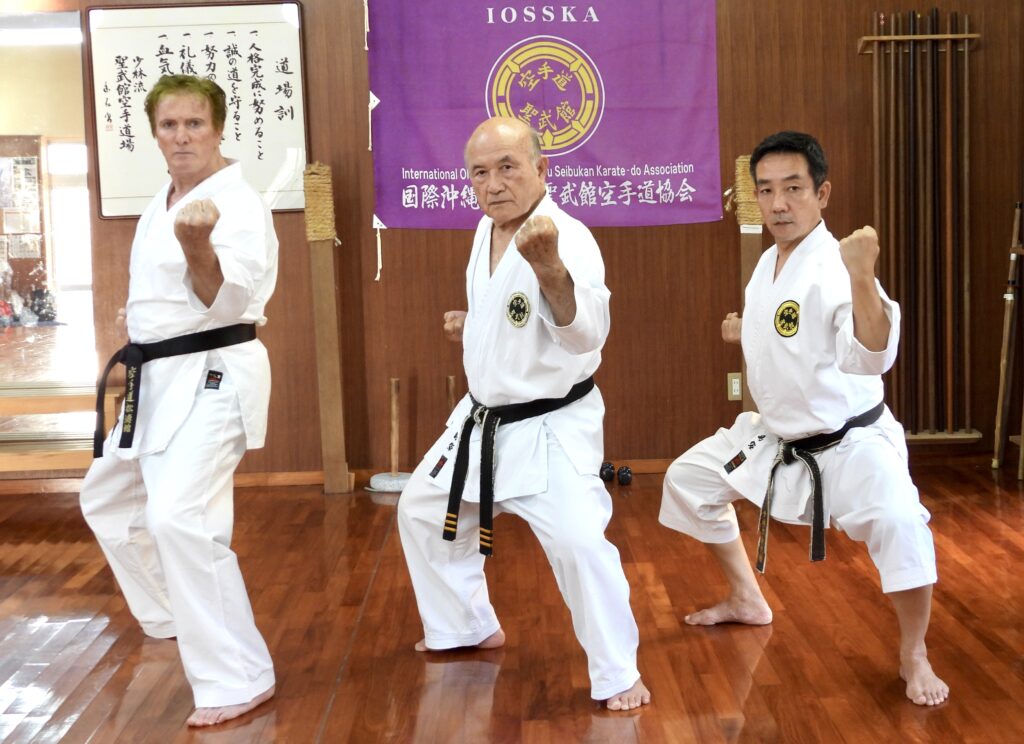
“Chudan uke kamae”. Zenpo Sensei and Zenshun Shihan (Shorin-Ryu) and Uchi-uke (Shotokan-ryu) by Daniel Sensei.
(8-) What do you think about Karate becoming a competitive sport with Olympic ambitions?
I believe that the global exposure of Karate through competition will allow a better popularization. People will finally learn that its source is Okinawa and this synergy will have the effect of bringing practitioners to traditional Karate. There are people who think that competition Karate is pretty, but for us here, we immediately judge that it is not a martial technique.
(9-) What is the significance of Karate as a martial art today?
It is important for humanity, because it emphasizes the need to build a strong body through rigorous training, as well as trying to build character…. Karate contributes to the development of beautiful humanity in my opinion. The personality of the teacher is extremely important. Karate leaders must teach moral principles and point out where and when problems arise…. Students will listen and will correct themselves.
(10-) How do you see the future of Karate?
Although we don’t know what the future will bring, I hope that teachers will not forget to convey the meaning of Okinawan traditions. I am thinking particularly of こだわり (kodawari) which is the commitment to preserve values, mentality, and to aspire to peace, as well as everything that represents the cultural heritage that we hold from our predecessors.
A teacher should never turn a blind eye when a student goes off the trails or develops his own Karate. He must have the heart and the courage to do his job as a guide without compromise. I sincerely hope that there will be many good Karateka and teachers who will understand it and who will respect and enforce this essence of traditional Okinawan Karate…

Shimabukuro Hanshi has just taught another secret to Daniel who is happy!
(11-) Do you have a message for the world?
Yes, I want all Karateka to know that Okinawa is indeed the source of Karate, while understanding what represents its traditional and cultural value.
(12-) What does Karate mean to you?
A kind of friend for life who encourages me! I am naturally optimistic, but if I have worries, fear, anger, I come to the Dojo and I do Makiwara, Kata as hard as possible until I sweat profusely and all my worries disappear… The philosophy that I teach consists of living healthily and happily through Karate training. I wish we could direct our forces towards a world free of conflicts with the idea of possible coexistence. I have the impression that my mission on Earth is to teach daily Karate in order to stimulate my students and to encourage successors.
Daniel Sensei’s conclusion: I realize once again, that for a Karate teacher, it is more important to sharpen and polish his personality rather than his technique. I want Karateka around the world to listen to this!
Thank you Sensei for this wonderful interview.
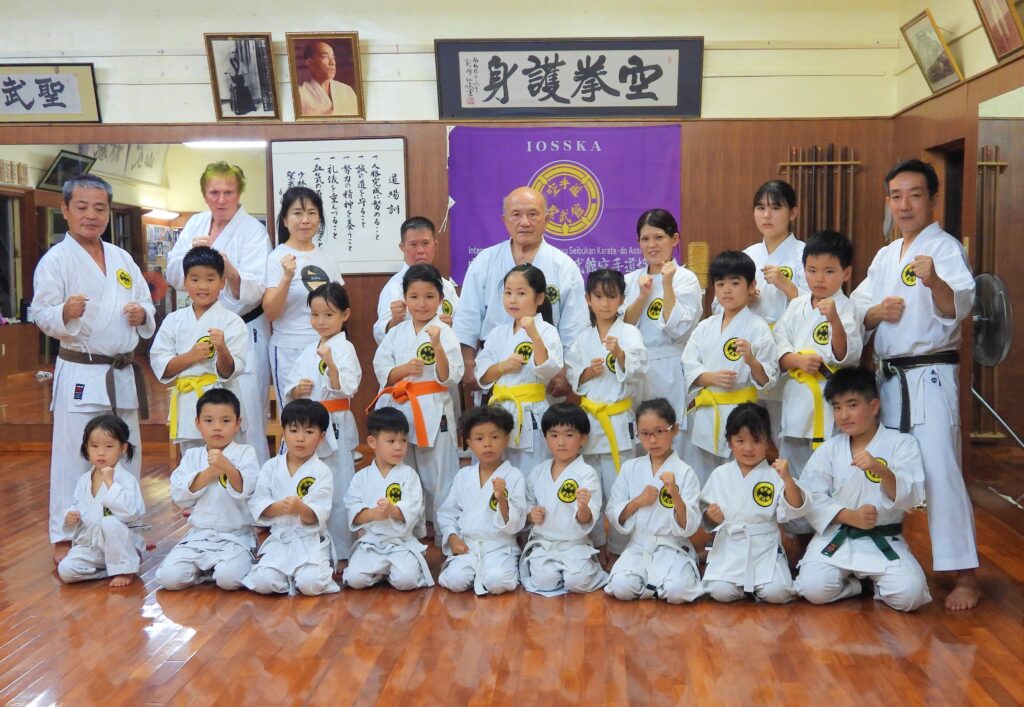
With the junior team of Shorin-ryu Seibukan Okinawa Souhonbu Dojo.
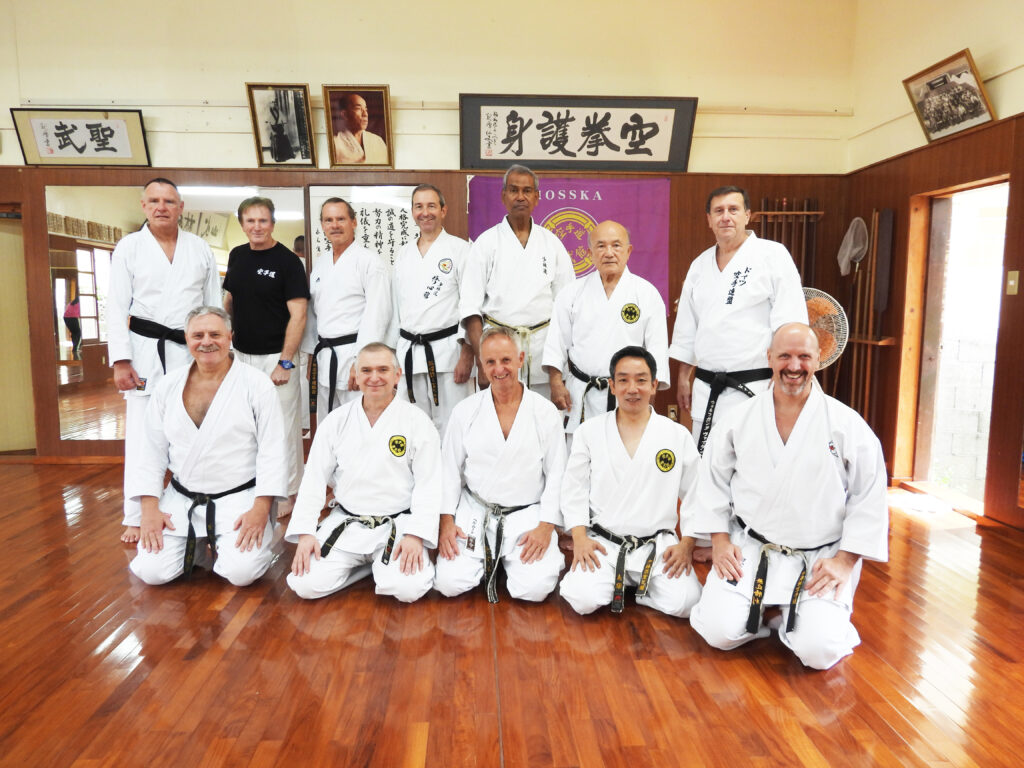
A delegation from the Seibukan German branch is visiting.

Daniel Mardon; the Karateka-Therapist
Creator of Aromapressure® method and physiotherapist with a valid US license, Daniel Mardon was born in Paris. One of his specialties is to teach and to perform lymphedema and subcutaneous tissue-damage care, after radiotherapy for cancer patients at medical institutions and subcutaneous tissue-circulation stimulation before and after surgery.
He was also a therapist for two famous soccer teams in Paris. Since 2005, he has focused on producing top-class hotel spas in Japan, as well as physiotherapy education and awareness-raising activities for health care professionals. Author of several books, among his major publications includes “The Physiology and Bodywork of Physical Therapy ” (Published by BAB Japan) and DVD “Daniel Mardon Aromapressure® Method ” (Pony Canyon). He regularly appears on television and radio shows, and has featured in numerous media publications.

